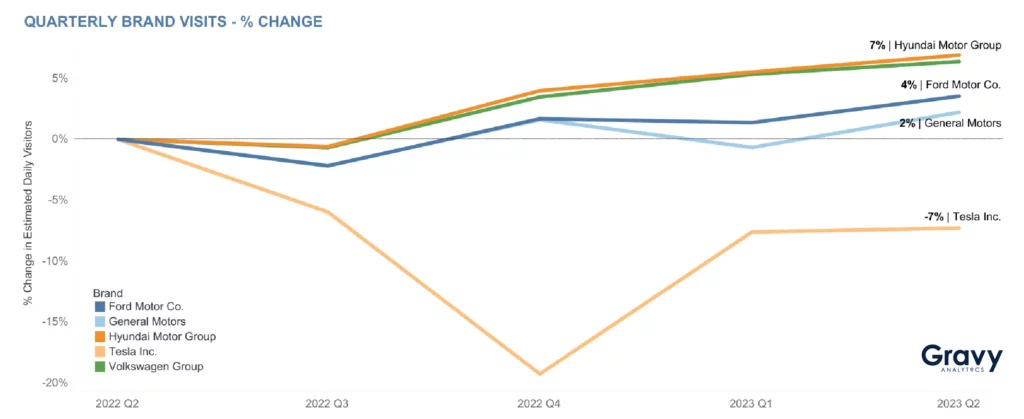How Does Consumer Foot Traffic to Tesla Showrooms Reflect Changing Car Buying Preferences?
July 13, 2023

In the last couple of years, there has been a widespread, rapid growth of consumer interest in electric vehicles (EVs). In fact, 71% of Americans have expressed at least some level of interest in buying or leasing electric cars. Not only that, but there has been a 12.5% increase in EV manufacturing businesses this year compared to 2022. As EV manufacturing expands and product offerings broaden, there has also been a notable overall rise in consumer interest toward purchasing cars of all types. With the demand for vehicles on the rise, and as consumer interest in EVs grows, what does foot traffic look like for Tesla, the market leader in electric vehicles?

Tesla has recently seen a significant amount of company growth, boasting a 30% increase in sales so far this year. With consumer interest favoring companies like Tesla, is foot traffic to Tesla showroom locations booming? Furthermore, how can Tesla’s recent foot traffic data help us understand more about current consumer trends?
To learn more, we analyzed consumer foot traffic data to Tesla locations, as well as its major competitors including Ford, General Motors, Hyundai, and Volkswagen.
Foot Traffic to Tesla Showroom Locations
We analyzed foot traffic to Tesla showrooms and the dealerships of its major competitors in the automotive industry from Q2 2022 to Q2 2023. Overall, foot traffic to Tesla locations fell by 7% year-over-year. In contrast, all of Tesla’s key competitors that we analyzed saw increases in year-over-year foot traffic. General Motors, Ford, and Volkswagen saw increases of 2%, 4%, and 6%, respectively. Hyundai saw the greatest increase in year-over-year foot traffic in this category, with a significant growth of 7%.

Among all the brands we analyzed, Tesla stood out with the most distinct foot traffic trends, being the only brand to experience a decline in foot traffic to its locations. After a slight decline in foot traffic levels in Q3 2022, Tesla experienced a sharp decline in Q4 2022, and a major rebound by Q1 2023. While this rebound was significant, Tesla has not experienced the same levels of foot traffic in Q2 2023 as it did in Q2 2022.
So, while recent consumer interest in EVs is rising, why might Tesla be losing consumer foot traffic to its showrooms this year compared to last year? And, could foot traffic to Tesla locations increase as 2023 progresses?
Tesla’s Buying Experience
Consumer interest in EVs, coupled with the recent rise in discretionary spending, is likely boding well for Tesla. In fact, Tesla recently reported stronger-than-expected vehicle deliveries and production numbers for the second quarter, despite attracting less foot traffic to its showrooms year-over-year. This can likely be attributed to Tesla’s unique buying experience.
With many other car brands, consumers can head to a dealership, buy a car, and drive off the lot in a new car on the same day. However, Tesla sells to its customers directly on its website. In fact, customers cannot buy a car from a Tesla showroom as Tesla showroom locations are solely for viewing and test driving purposes. Tesla’s direct-to-consumer buying model offers its customers a more convenient and hassle-free experience. For Tesla customers, there is no need to negotiate with salespeople, and they can customize their own vehicle with certain preferences, such as paint color, before buying.
The difference between the buying experience at Tesla versus traditional car dealerships is likely contributing to the unique foot traffic patterns Tesla experienced over the past year, as Tesla customers do not need to visit a showroom to purchase a car. The Tesla buying experience appeals to consumers’ growing interest in convenience while aligning with their growing affinities for EVs. This trend also signifies a heightened desire for a streamlined car buying process among consumers, which could mean a growing customer base for Tesla and increased competition as other car brands explore EV products.
Tesla: Disrupting the Auto Industry
Tesla’s disruption of the traditional car buying experience not only sets the company apart from competitors but also attracts a larger customer base. Furthermore, Tesla’s innovative approach solidifies the brand as a leader in the EV market.
For example, recently, Mercedes-Benz joined a growing list of automakers adopting Tesla’s standard for vehicle charging, expanding the accessibility of Tesla charging stations to more EV drivers. Alongside several other brands, Mercedes-Benz is integrating Tesla’s North American Charging Standard into its EV lineup. As more companies adopt this standard, Tesla will strengthen its position as the leader in the EV market. With this growth will come heightened competition from other brands, potentially leading to increased foot traffic at competitors’ locations.
One thing is for sure: consumers are growing more and more interested in driving EVs, and Tesla seems to appeal to a number of consumer interests in the automotive market. So, whether this boosts foot traffic to Tesla showroom locations or not, Tesla’s success will likely continue this year.
For more foot traffic analyses and consumer insights like this, subscribe to our email newsletter.




